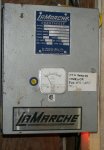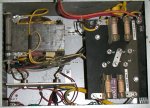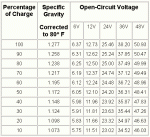- 3,657
- 27
- 48
- Location
- Dallas, Texas
We really need a topic to discuss regular battery chargers. Since you can't just to to the wal-mart and buy a 24V unit, we can use industrial kinds (or modify one like I did before, but that one is not in any way regulated, and I want to address professional types separately than modifications)_
I picked up this little gem today. It's a LaMarche Constavolt A5E-10-24V-A1, and came from DRMO. It's about as old as the deuce.. Charged at up to 10 amps, and then when the batteries are full, switches to tricke, then pulse. This is all done with a saturable reactor, and the only electronic parts are the rectifier diodes.
The power cable and battery cable had to be replaced and I added a power switch and pilot lamp underneath. The unit mounts on the wall in the garage, on a piece of plywood that also holds the automatic transfer switch for my emergency power system. I made the battery cables out of a 100FT extension cord since the current is only 10A and when it comes time for the float charge, the current is so slight that the voltage drop is fairly negligible. Judging by the voltage drop at 4A (measured at the batteries and at the charger), the resistance of the the long cable is about 1 ohm. This is a very significant amount of resistance but since it's just to maintain the batteries not fast-charge them, it's fine with me. I need to figure out the correct voltage for floating wet lead-acid batteries.
in the "inside" picture, on the right beneath the terminal board is a saturable reactor. The jumpers 1-6 are for setting the unit for whatever AC input voltage is present, in my case the 120V seting for 117V measured voltage should be fine. Unit has two fuses for the AC input and two for the DC output. On the right is the power transformer, rated about 600 watts. I don't know what the resistor is for, but i suspect it sets the current in the saturable reactor. Note there seem to be two marks on the resistor. I think that the movable tap might have been in between these originally, but I am not messing with it until I understand itnbetter. Below the transformer is the rectifer.
In the pic of the front panel, note the red glow underneath. This is the pilot light. Note: I used a 36V lamp so it would not burn out
OK so it's just another gadget but I like it!
I picked up this little gem today. It's a LaMarche Constavolt A5E-10-24V-A1, and came from DRMO. It's about as old as the deuce.. Charged at up to 10 amps, and then when the batteries are full, switches to tricke, then pulse. This is all done with a saturable reactor, and the only electronic parts are the rectifier diodes.
The power cable and battery cable had to be replaced and I added a power switch and pilot lamp underneath. The unit mounts on the wall in the garage, on a piece of plywood that also holds the automatic transfer switch for my emergency power system. I made the battery cables out of a 100FT extension cord since the current is only 10A and when it comes time for the float charge, the current is so slight that the voltage drop is fairly negligible. Judging by the voltage drop at 4A (measured at the batteries and at the charger), the resistance of the the long cable is about 1 ohm. This is a very significant amount of resistance but since it's just to maintain the batteries not fast-charge them, it's fine with me. I need to figure out the correct voltage for floating wet lead-acid batteries.
in the "inside" picture, on the right beneath the terminal board is a saturable reactor. The jumpers 1-6 are for setting the unit for whatever AC input voltage is present, in my case the 120V seting for 117V measured voltage should be fine. Unit has two fuses for the AC input and two for the DC output. On the right is the power transformer, rated about 600 watts. I don't know what the resistor is for, but i suspect it sets the current in the saturable reactor. Note there seem to be two marks on the resistor. I think that the movable tap might have been in between these originally, but I am not messing with it until I understand itnbetter. Below the transformer is the rectifer.
In the pic of the front panel, note the red glow underneath. This is the pilot light. Note: I used a 36V lamp so it would not burn out
OK so it's just another gadget but I like it!
Attachments
-
58.5 KB Views: 1,645
-
124.9 KB Views: 1,645
Last edited:





